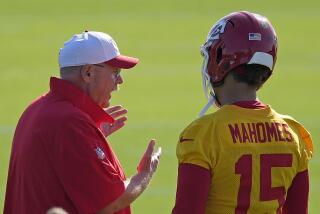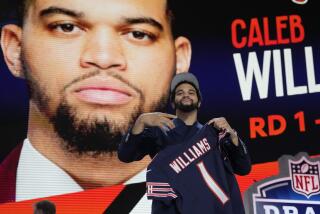‘Elway to Marino’ chronicles quarterback draft that changed NFL
- Share via
Thirty years ago this week, the NFL teetered on wobbly legs.
It was coming off the 1982 player strike, Raiders owner Al Davis had just successfully sued the league for the right to move his team to Los Angeles, the USFL was poaching players -- including Heisman Trophy winner Herschel Walker -- and John Elway, who would be selected No. 1 overall in the draft, was threatening to play for the New York Yankees if the Baltimore Colts used the first pick on him, which they did.
That’s the backdrop for the ESPN Films “30 for 30” documentary “Elway to Marino,” which debuts Tuesday at 5 p.m. PDT and re-airs at 6:30 p.m.
It’s NFL Films’ first piece for the critically acclaimed “30 for 30” series, and is directed by Ken Rodgers, who runs the “Hard Knocks” show.
“Elway to Marino” is a behind-the-scenes look at how the first round of the 1983 draft unfolded, using as a roadmap the just-revealed personal diary of agent Marvin Demoff, who represented both Stanford star Elway and Dan Marino, who tumbled nearly to the end of the round before being selected 27th by Miami.
Rodgers called the first round a “transformative” moment for the NFL, which had yet to emerge from the shadow of Major League Baseball as America’s most popular sport.
“The draft, the power of the ESPN relationship, and the players on the field,” he said, “changed generations on this day, April 26, 1983, and especially in those three hours, 14 minutes of the first round when six Hall of Famers were drafted and the fortunes of players, coaches, franchises, owners all changed. You can see just by looking at the list of who was drafted, what the next 10 years held for certain franchises.”
The best example of what might have been belongs to the Pittsburgh Steelers, who passed on hometown hero Marino at 21 and instead selected Texas Tech defensive lineman Gabriel Rivera. The Steelers reasoned they still had at least a couple of years remaining with quarterback Terry Bradshaw.
One quarter into the 1983 season, Bradshaw suffered a career-ending elbow injury. Rivera lasted six games before driving drunk and getting into an accident that paralyzed him.
There were less dramatic but still profound missteps by other teams, including the Philadelphia Eagles drafting running back Michael Haddix -- whose average of 3.0 yards per carry set a league record for futility -- one pick before the Houston Oilers took future Hall of Fame offensive lineman Bruce Matthews.
There are all sorts of fascinating revelations in “Elway to Marino,” among them:
• Legendary San Francisco Coach Bill Walsh was weighing the merits of trading Joe Montana to acquire Elway, whom he recruited to Stanford.
• Raiders owner Davis believed that then-Commissioner Pete Rozelle conspired to stop a trade that would send Elway to L.A.
• Gene Klein, who then owned the San Diego Chargers, feigned interest in trading for Elway to win contract negotiations with Dan Fouts.
• Had the New York Jets taken Marino, the Dolphins were prepared to take UC Davis quarterback Ken O’Brien. Instead, the Jets took the solid but unspectacular O’Brien 24th.
• Ernie Accorsi, then general manager of the Colts, felt he needed a top-six pick in any trade for Elway because he wanted to pick Marino. He was convinced that Kansas City was going to take Marino at 7.
The star of the 1 1/2-hour film is Demoff’s handwritten diary, which details virtually every conversation with team owners, executives and coaches. It was unusual for him to document a draft that way, but he had told the Elways -- John and his father, Jack -- that he believed a player should have some say about where he winds up, and John Elway had leverage because he had baseball in his back pocket.
“The diary was my way of keeping track so I could relay every bit of information back to John and Jack,” Demoff said.
The 1983 draft, Demoff said, “accentuated the idea that to be really relevant, teams needed a franchise quarterback. If you didn’t have a quarterback, it was like playing chess without a queen.”
For Rodgers, the biggest revelation in making the film was ... when it comes to the NFL draft, we don’t know what we don’t know.
“What it makes you realize is that even today, in this upcoming 2013 draft, we can act like we know what teams are thinking all we want, but we really don’t,” he said.
“For 30 years people have been talking about this draft as the most important draft in NFL history, the most crucial draft, the round that produced the greatest players in NFL history, and we’re still hearing stories about what happened during it 30 years later.”
ALSO:
NFL draft preview: AFC and NFC East
NFL draft preview: AFC and NFC South
NFL beat writers make picks for 2013 mock draft
More to Read
Go beyond the scoreboard
Get the latest on L.A.'s teams in the daily Sports Report newsletter.
You may occasionally receive promotional content from the Los Angeles Times.











